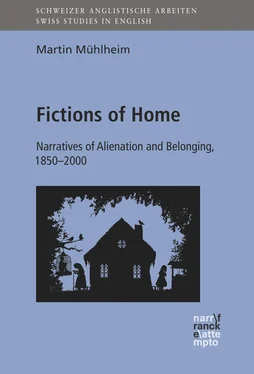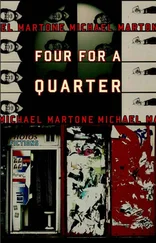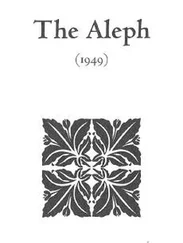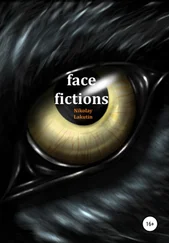The idea of home ranges across various scales (diagram adapted from FoxFox, Michael Allen 19).
This conceptual range is far from a critical disadvantage. Rather, home is a powerful tool for literary and cultural analysis precisely because it is a multi-scalar and open concept that allows us effortlessly to relate our smallest and most intimate concerns to matters of truly globalglobal and globalization importance. Indeed, it is by focusing on the manifold dimensions of home – as a place of residenceresidence or sheltershelter; as a network of given as well as of chosen relationships; as a repository of both individual and collective ideals (Alyson BluntBlunt, Alyson and Robyn Dowling 100; FoxFox 6); as a story of origins, waypoints, and destinations; or as a site of violenceviolence and exclusionexclusion (Rose MarangolyGeorge, Rose Marangoly George 9; SandtenSandten, Cecile and TanTan, Kathy-Ann 8) – that we can develop critical questions, especially in situations where the term’s multiple meanings are difficult, or indeed impossible, to reconcile. As a theoretical concept, in short, home allows us to explore a dialecticdialectic movement of alienationalienation and belonging that, in turn, is able to generate extraordinary passion, in all the senses of that word: desiredesire and yearning; fervor, agony, and rage; but also feelings very much like lovelove.
Fictions of Home: Theoretical Framework
The core theoretical assumption of this study is that fictions are home-makinghome-making practices, and we will soon examine this idea more closely. It may be helpful, however, first to say a word or two about the way in which this chapter is structured, as well as to comment on the general trajectory of this study. If, for instance, this first subsection is entitled “Theoretical Framework ,” then this is because the ideas developed here will not be discussed explicitly in the main chapters of this study. Instead, they constitute a way of framing the overall argument, and will accordingly be revisited in the concluding chapter. In addition, the discussion of E.T. in the remainder of this introduction is not intended to develop a comprehensive reading of SpielbergSpielberg, Steven’s film. Rather, the aims of the discussion are:
(a) to introduce key ideas and concepts relating to home and belonging, as they have been proposed by various theoretical schoolsschool;
(b) to exemplify the interpretive power of these concepts by applying them to SpielbergSpielberg, Steven’s film;
(c) to indicate, roughly, which of these ideas and concepts are central to which of the six main chapters of this study.
We will also examine briefly the choice of primary texts, as well as some important caveats regarding the scope of the overall argument. The introductory chapter does not, however, summarize the findings of the six main chapters; these will, instead, be presented in the conclusion.
If, in this chapter and the ones that follow, the argument will often have a meandering quality, then this is a matter of conscious choice, for in order to ‘get’ home – in the sense of understanding it – we must be willing to travel wide and far: to explore its connections to the wider world, as well as its complex internal relations. Home-making thus requires a degree of patience, and the style ofstyle the argument is to some extent meant to reflect this fact. At the same time, being patient is not the same as tolerating aimlessness or boredom, so that a plea for the former ought not to be misconstrued as an appeal for the latter.
The key ideas formulated in the remainder of this introductory chapter can be summarized in the form of seven partly overlapping precepts:
1 Even in a secularsecular analysis of home, we must bear in mind the foundational, metaphysicalmetaphysical dimension of questions of belonging. This means to consider, among other things, religious beliefs and motifs (such as the idea of a transcendental home) as well as agnosticagnosticism or atheistatheism accounts of existentialexistential & existential angst/trauma angst or traumatrauma and shell shock (in the sense of a not-being-at-home in the world).
2 References to other texts (especially canonical ones), as well as to established generic traditions, can be understood as home-makinghome-making practices because they add a dimension of familiarityfamiliarity to an unfamiliar text. However, at the same time, we need to analyze carefully the precise way in which these intertextualintertextuality references relate (a) to the text in which they occur, and (b) to each other, as this may alert us to important intertextualintertextuality entanglements, which in fact serve to defamiliarize and critique the traditiontradition.
3 Familiarity, predictability, and a sense of controlcontrol are essential features of homelyhomely homes; they arise, among other things, from habitualhabits and the habitual practices and ritualritual actions, and they constitute ‘energyenergy-saving devices’ that allow humans to focus their limited mental and physical resourcesresources on tasks of their choice (rather than having to expend all their energy on the challenges of everydayeveryday life). However, too much familiarityfamiliarity can constitute an obstacle to understanding and (selfself-)knowledgeknowledge, which is why alienation effectalienation effects and defamiliarizdefamiliarizationing practices are necessary tools for critical inquiry (whether deployed in works of art or by critics, scholars, and other analysts).
4 It is by no means a coincidence that the terms communitycommunity and communicationcommunication are so similar to each other, as communication is central to the establishment and maintenance of a sense of home. One factor that facilitates successful communication is a shared cognitivecognition and cognitive background (established, for instance, through shared experiences), while another crucial factor is the distribution of communicative resourcesresources. As this distribution is unequal, some will find it easier than others to establish and maintain a sense of home (e.g. in the case of diasporicdiaspora communities).
5 Psychoanalysis provides us with powerful concepts for analyzing home – both through FreudFreud, Sigmund’s notion of the uncannyuncanny and, more generally, through complex techniques of decoding that allow us to unearth the unconscious forces that shape personal as well as collective identities, and which influence the very form of works of art.
6 Even the supposedly private home is a site that is permeated by relations of power, and we must always take into account the political forces that help to shape the home (as well as the individual and collective identities associated with that home). These forces include:(a) the marginalization of others on the basis of race or ethnicityethnicity;(b) cultural discourses about ideal homes – including the construction of ‘normal’ as opposed to ‘deviant’ forms of desiredesire – and how they are diffused through various mediamedia, even in the home itself;(c) the gendering of domestic space and how it relates to structures of domination (e.g. patriarchypatriarchy as a social system);(d) classclass relations (e.g. the productionproduction of social stratification through economic inequalityinequality, and how it appears in, and sustains or undermines, particular types of home).
7 Any critical analysis of home must focus not only on the contentcontent or ingredients of home, but also on their formalform and content arrangement. Indeed, the core theoretical assumption of this study is formalform and content in nature: that the concepts of fiction and home are structurally akin to each other because they involve the same form of fictionalizing negotiation between the two realms of the real and the imaginary. One implication of this assumption is that a better understanding of fiction also contributes to our understanding of home and belonging.
Читать дальше












